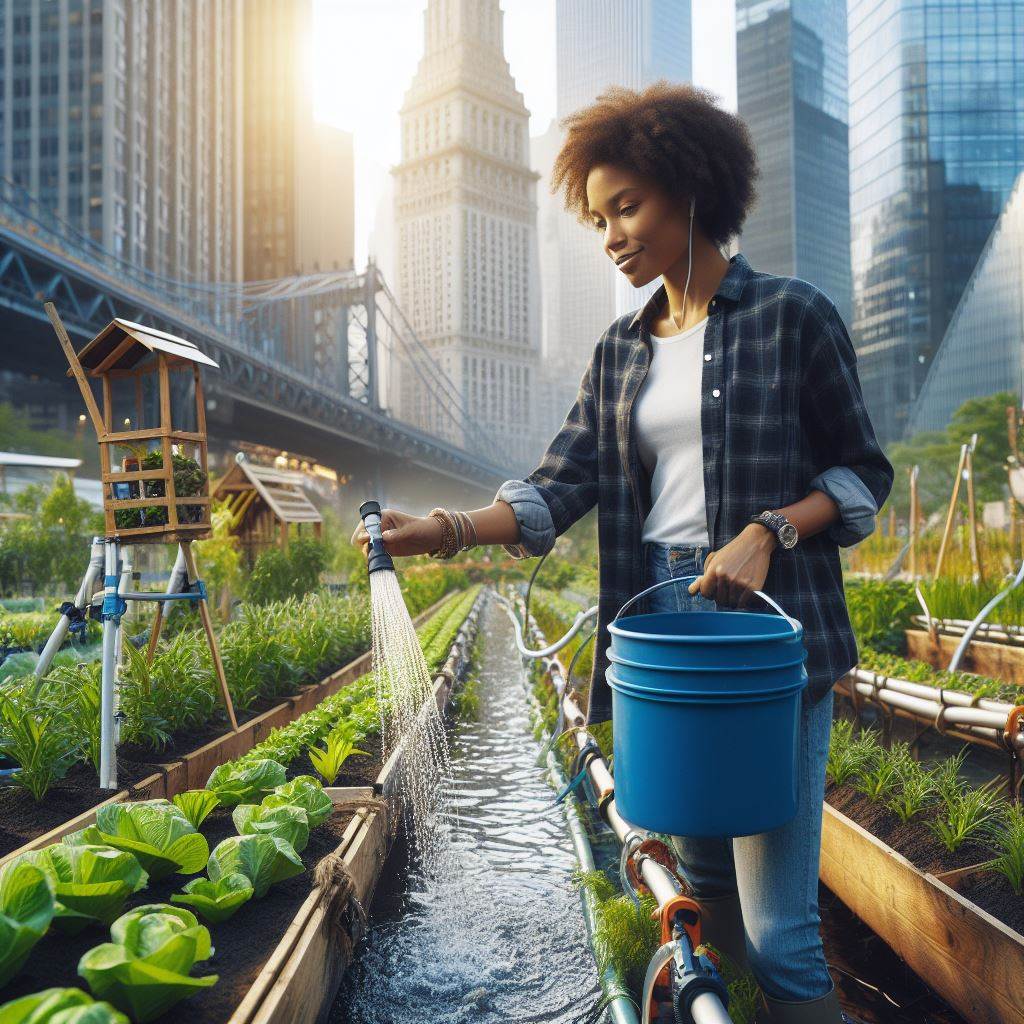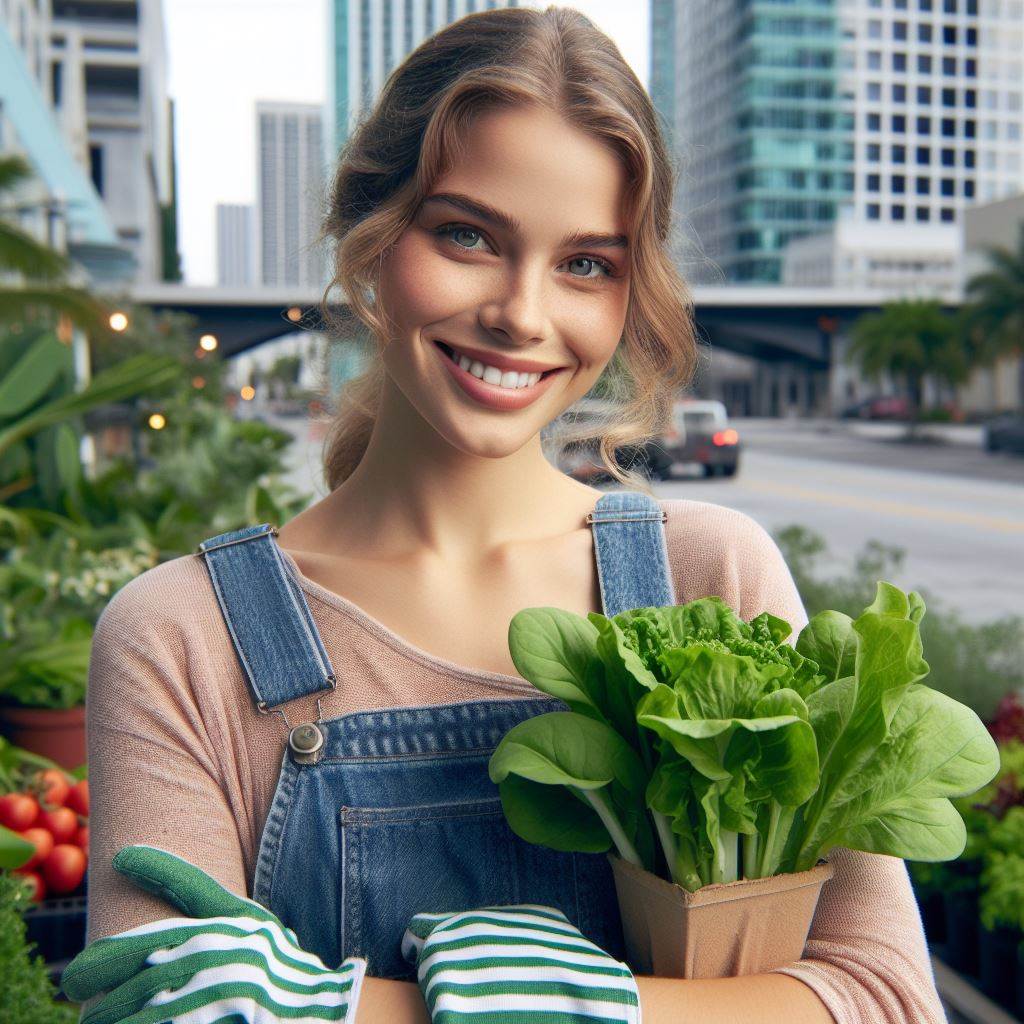Introduction
Implementing Urban Farm Water Saving Methods is crucial in urban farming, where water resources are often limited.
These methods can not only help conserve a valuable natural resource but also contribute to the sustainability and success of urban farming practices.
One of the top water-saving methods in urban farming is drip irrigation.
This system delivers water directly to the plant’s root system, minimizing water loss through evaporation and ensuring efficient water usage.
Additionally, using mulch can aid in reducing water loss by preventing soil evaporation.
Another effective method is the use of rainwater harvesting systems.
Collecting rainwater allows farmers to utilize a natural water source, reducing dependency on traditional water supplies.
Installing rain barrels or rooftop collection systems can provide a sufficient amount of water for irrigation needs.
Implementing smart irrigation technology is also crucial in urban farming.
These automated systems monitor weather conditions and soil moisture levels, adjusting irrigation schedules accordingly, and avoiding unnecessary water wastage.
Furthermore, promoting soil health is vital in water conservation.
Improving soil structure through the addition of organic matter enhances water retention capacity, reducing the frequency and amount of water required for irrigation.
Lastly, crop selection plays a significant role in water-saving efforts.
Opting for drought-tolerant plants and using native varieties adapted to local conditions can minimize water usage in urban farming.
Basically, adopting these top 5 effective water-saving methods in urban farming can contribute to the sustainability and efficiency of this practice.
Transform Your Agribusiness
Unlock your farm's potential with expert advice tailored to your needs. Get actionable steps that drive real results.
Get StartedBy conserving water resources, urban farmers can ensure continuous production while reducing environmental impact and promoting a greener future.
Drip Irrigation Systems
How drip irrigation systems work
- Drip irrigation is a method where water is directly delivered to the plant’s roots using a network of tubes.
- A small amount of water is dripped slowly and consistently, targeting the root zone.
- This system can be automated, ensuring plants receive the right amount of water without wastage.
- Drippers, emitters, or micro-sprinklers are used to control the flow and rate of water.
- Overall, drip irrigation conserves water and reduces evaporation by delivering water directly to the plants’ roots.
Benefits of using drip irrigation systems in urban farming
- Water conservation: Drip irrigation systems use up to 50% less water compared to traditional watering methods.
- Reduced weeds and diseases: By delivering water directly to the roots, weed growth is minimized, and foliage remains dry, reducing the risk of diseases.
- Improved plant health: Precise water delivery ensures plants receive adequate moisture, resulting in healthier growth and higher yields.
- Time and energy-saving: Drip irrigation systems require less maintenance and labor compared to manual watering methods.
- Flexibility and scalability: Drip systems are adaptable and can be customized to fit various crop types, sizes, and layouts, making them suitable for urban farming in limited spaces.
Examples of successful implementation of drip irrigation systems in urban areas
- The Rooftop Gardens Project in New York City utilizes drip irrigation to efficiently water their vegetable gardens, maximizing limited rooftop space.
- The Los Angeles Urban Farming Initiative employs drip irrigation systems in their community gardens, contributing to water conservation efforts in the city.
- In Tel Aviv, Israel, rooftop farms implement drip irrigation to grow crops in urban areas with limited access to water resources.
- The Singapore High-Tech Rooftop Farming Project employs advanced drip irrigation systems to cultivate a diverse range of crops in the city-state’s urban environment.
- The Melbourne Sustainable Urban Farming Program in Australia uses drip irrigation to grow fresh produce in community gardens, promoting sustainable urban agriculture.
Drip irrigation systems have proven to be highly effective in promoting water-saving methods in urban farming.
By delivering water directly to the plants’ roots and minimizing evaporation and runoff, these systems conserve significant amounts of water.
Additionally, the precise control offered by drip irrigation ensures optimal plant health and higher crop yields.
Successful implementation in various urban farming projects around the world demonstrates the versatility and scalability of drip irrigation systems.
As urban areas continue to face water scarcity challenges, the adoption of these water-saving techniques becomes crucial for sustainable urban agriculture.
Read: Marigolds: More Than Just Pretty
Rainwater Harvesting
Overview of rainwater harvesting and its relevance to urban farming
- Rainwater harvesting is the process of collecting and storing rainwater for future use.
- It is an effective method for urban farms to conserve water and reduce their reliance on the public water supply.
- With increasing water scarcity and the need for sustainable agriculture, rainwater harvesting has gained popularity.
- By utilizing rainwater, urban farms can ensure a steady supply of water for their crops.
Techniques for collecting and storing rainwater in urban settings
- Install rain barrels or tanks to collect rainwater from rooftops.
- Use gutter systems to direct rainwater towards storage containers.
- Implement filtration systems to remove debris and contaminants from collected rainwater.
- Ensure proper maintenance of the storage system to prevent water leakage or contamination.
- Consider underground cisterns or tanks for larger-scale rainwater storage.
Examples of urban farms utilizing rainwater harvesting effectively
- Harvest Farms in Denver, Colorado, uses rainwater harvesting to irrigate their crops and reduce reliance on the city’s water supply.
- Brooklyn Grange in New York City collects rainwater from their rooftop farm, which helps them grow organic produce sustainably.
- The Seattle Urban Farm Company employs rainwater harvesting techniques to ensure water availability for their urban farming projects.
- Urban Adamah in Berkeley, California, collects rainwater to irrigate their farm and provide water for educational programs.
- Growing Power in Milwaukee, Wisconsin, utilizes rain barrels to collect rainwater, promoting water conservation and self-sufficiency.
Benefits of Rainwater harvesting
Benefits of Rainwater harvesting is an effective method for urban farms to save water and promote sustainability.
By collecting and storing rainwater, urban farmers can optimize their water usage and reduce the strain on municipal water supplies.
Furthermore, rainwater is often free from the chemicals found in tap water, making it a healthier option for irrigating crops.
Implementing rainwater harvesting techniques in urban settings requires appropriate infrastructure, such as rain barrels, tanks, and filtration systems.
Rooftop farms provide an ideal platform for rainwater collection, allowing water to be easily channeled into storage containers.
Filtration systems are crucial to remove debris, sediments, and potential pollutants from collected rainwater before use.
Regular maintenance and inspection of the rainwater harvesting system are necessary to ensure its efficiency and longevity.
There are several successful examples of urban farms that have integrated rainwater harvesting into their operations.
These farms not only save water but also produce healthy and sustainable food for their local communities.
Rainwater harvesting promotes self-sufficiency and reduces the carbon footprint associated with transporting water over long distances.
Essentially, rainwater harvesting is a valuable method for urban farms to conserve water and promote sustainable agriculture.
By utilizing techniques such as rain barrels, tanks, and filtration systems, urban farmers can collect and store rainwater effectively.
Examples of urban farms successfully implementing rainwater harvesting showcase its relevance and benefits in an urban farming context.
Supporting and encouraging the use of rainwater harvesting in urban agriculture can contribute to a more sustainable and water-wise future.
Read: Soil Health for Pest/Disease Control
Mulching
Mulching and its role in water conservation
- Mulching refers to the process of covering the soil with a layer of organic or inorganic materials.
- It helps in preventing water evaporation from the soil surface by acting as a protective barrier.
- The mulch layer helps in retaining moisture, reducing the need for frequent watering in urban farming.
- This technique significantly reduces water wastage and promotes efficient water use.
- Moreover, mulching also regulates soil temperature, suppresses weed growth, and prevents erosion.
Benefits of using mulch in urban farming
- Mulching conserves water by reducing evaporation, allowing the plants to make the most of available moisture.
- The layer of mulch acts as a natural insulator, providing a more stable and optimal environment for plant roots.
- By maintaining consistent soil moisture, mulching helps plants resist drought stress, improving overall crop yield.
- Organic mulches like straw, wood chips, or compost add nutrients to the soil as they break down over time.
- Mulching also aids in weed control, minimizing competition for water and nutrients among plants.
Examples of successful urban farms implementing mulching techniques
Urban Los Angeles Farm
- Located in the heart of the city, this farm incorporates mulching into their water-saving strategies.
- They use shredded leaves collected from nearby parks as a free and readily available mulching material.
- By applying a thick layer of mulch around their fruits and vegetables, they have reduced water consumption by 30%.
New York City Urban Farm
- This rooftop farm utilizes compost as their primary mulching material.
- The compost not only conserves water but also enriches the soil, resulting in healthier and more productive plants.
- They have observed a 50% reduction in water usage since implementing mulch in their farming practices.
Urban Farm Melbourne
- Using gravel as a mulching material, Urban Farm Melbourne has seen remarkable water-saving benefits.
- The gravel layer prevents water evaporation and provides a well-draining medium for their crops.
- The farm has managed to decrease their water consumption by 40%, contributing to a sustainable urban ecosystem.
In general, mulching is a highly effective method for water-saving in urban farming.
By acting as a protective cover, mulch reduces water evaporation, conserves moisture, and promotes plant health.
Showcase Your Farming Business
Publish your professional farming services profile on our blog for a one-time fee of $200 and reach a dedicated audience of farmers and agribusiness owners.
Publish Your ProfileIt also offers additional benefits like weed control, soil temperature regulation, and prevention of erosion.
Various successful urban farms have experienced substantial water savings through the implementation of mulching techniques.
Therefore, incorporating mulching into urban farming practices can greatly contribute to sustainable and efficient water use.
Read: Herbal Mixes to Protect Your Plants

Micro-sprinkler Systems
Brief description of micro-sprinkler systems and their advantages
- Micro-sprinkler systems are irrigation techniques that use small devices to deliver water directly to plant roots.
- These devices, known as micro-sprinklers or micro-sprayers, are designed to distribute water in a gentle and targeted manner.
Micro-sprinkler systems offer several advantages:
- Efficient water distribution: Water is applied directly to the plant’s root zone, minimizing evaporation and runoff.
- Reduced water waste: The precise delivery system ensures that only the necessary amount of water is used, preventing overwatering.
- Flexibility and adaptability: Micro-sprinklers can be easily adjusted to accommodate different plant types, sizes, and growth stages.
- Improved plant health: By delivering water at the root zone, micro-sprinklers promote healthier plant growth and reduce the risk of diseases.
How micro-sprinkler systems can be tailored to urban farming needs
- Urban farming faces unique challenges, such as limited space and water availability, but micro-sprinkler systems offer practical solutions.
- These systems can be customized to fit the specific requirements of urban farms, ensuring efficient water usage and maximum crop yield.
- Adjustable flow rates: Micro-sprinklers can be adjusted to deliver specific water amounts based on the type of crop being grown.
- Spacing and coverage: Micro-sprinklers can be strategically placed to cover the entire growing area, even in small or irregularly shaped spaces.
- Integration with other technologies: Micro-sprinklers can be integrated with sensors and timers to automate watering schedules and optimize resource usage.
Real-life examples of urban farms benefiting from micro-sprinkler systems
Several urban farms have successfully implemented micro-sprinkler systems to maximize their water-saving efforts and crop production.
Urban Los Angeles Farm
- Urban Los Angeles Farm, located in the heart of the city, faced water scarcity due to restrictions and high costs.
- By installing micro-sprinkler systems, they reduced water consumption by 40% while still achieving healthy plant growth.
- Their tailored system accounted for different plant types and spatial limitations, proving the adaptability of micro-sprinklers.
Rooftop Garden New York City
- Rooftop Garden New York City utilized micro-sprinkler systems to overcome water limitations in their urban setting.
- By adjusting the flow rates and optimizing coverage, they achieved water savings of up to 50% compared to traditional irrigation methods.
- Their success demonstrated that micro-sprinklers can be scaled to fit rooftop farming needs efficiently.
Community Garden Melbourne
- Community Garden Melbourne prioritized water conservation in their community-focused urban farm.
- With micro-sprinkler systems, they minimized water waste and achieved significant reductions in their water bills.
- Community members appreciated their sustainable approach and were inspired to adopt similar practices in their own gardens.
Micro-sprinkler systems offer urban farmers an effective and adaptable method for conserving water.
These systems provide precise and efficient water distribution, tailored to the unique challenges of urban farming.
The real-life examples demonstrate the wide-ranging benefits of micro-sprinklers for water-saving in urban farming.
Read: Preventing Garden Pests Naturally
Vertical Gardening
Introduction to vertical gardening and its water-saving benefits
Vertical gardening is a unique technique that allows urban farmers to grow plants in a vertical arrangement, instead of the traditional horizontal method.
This method provides various benefits, including effective water-saving strategies.
One of the significant advantages of vertical gardening is its efficient use of water resources.
By utilizing vertical space, plants can be grown closer together, resulting in reduced water evaporation and better moisture retention within the soil.
Furthermore, vertical gardening can save up to 90% of water compared to traditional farming methods.
This significant water conservation is achieved through various techniques and tools specifically designed for setting up vertical gardens in urban environments.
Techniques and tools for setting up a vertical garden in an urban environment
- Installing a Drip Irrigation System: Implementing a drip irrigation system is crucial for water-saving in a vertical garden. This system allows water to be directly delivered to the plant’s root zone, minimizing wastage through evaporation or runoff.
- Using Self-Watering Containers: Self-watering containers are perfect for vertical gardens and urban farming. These containers have built-in reservoirs that store water, providing a consistent water supply to plants while conserving water.
- Choosing the Right Plants: Selecting plants that are well-suited for vertical gardening and urban environments is essential. Opt for plants with low water requirements, such as succulents and herbs, to minimize water usage and ensure their survival in limited space.
- Using Mulch: Applying a layer of organic mulch on top of the soil helps retain moisture, reduce evaporation, and suppress weed growth. This technique helps to optimize water usage in a vertical garden and promotes a healthier plant growth environment.
Successful stories of vertical gardening in urban farms
Many urban farms around the world have embraced vertical gardening as a sustainable and efficient method, showcasing outstanding success stories.
- The Plant Chicago: This urban farm in Chicago has transformed an old meatpacking plant into a thriving vertical garden. With the help of vertical shelves and hydroponic systems, they grow an impressive array of vegetables using minimal water.
- Lufa Farms: Based in Montreal, Lufa Farms utilizes rooftops for their vertical gardens, effectively saving water through innovative irrigation systems. They produce a large variety of crops year-round while significantly reducing water consumption.
- Brooklyn Grange: As one of the largest rooftop farming ventures, Brooklyn Grange has adopted vertical gardening as a sustainable practice. They use rooftop space efficiently, implementing proper irrigation techniques to grow organic produce with minimal water waste.
- The Urban Farmers: This Swiss organization has successfully implemented vertical gardening in urban areas, including repurposing old shipping containers. By using hydroponics and controlled irrigation systems, they achieve high crop yields while conserving water resources.
In essence, vertical gardening is a remarkable method that not only maximizes urban farming space but also offers effective water-saving solutions.
By following specific techniques and utilizing suitable tools, urban farmers can establish successful vertical gardens and contribute to sustainable agriculture practices.
Uncover the Details: Pollinator-Friendly Small Gardens: Tips
Conclusion
Recap of the top 5 effective methods for water-saving in urban farming
In this blog post, we have discussed the top 5 effective methods for water-saving in urban farming.
These methods include drip irrigation, mulching, rainwater harvesting, using drought-tolerant plants, and employing efficient watering techniques.
Importance of adopting these methods for sustainable urban agriculture
Water scarcity is a growing concern in urban areas, and it is crucial for urban farmers to adopt water-saving methods.
By implementing these techniques, we can conserve water resources, reduce water bills, and contribute to sustainable urban agriculture.
Closing thoughts and call to action for readers to implement water-saving techniques in their own urban gardens.
In a nutshell, water-saving techniques are not only beneficial for the environment but also for urban farmers in terms of cost-saving and efficient resource utilization.
Therefore, I urge all readers to take action and implement these water-saving methods in their own urban gardens.
Together, we can make a significant impact and create a sustainable future for urban agriculture.
Start today and be a part of a greener tomorrow!




